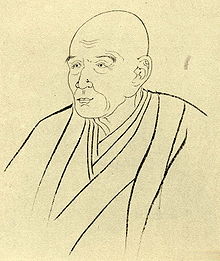Takizawa Bakin


Takizawa Bakin (曲亭 馬琴), a.k.a. Kyokutei Bakin (曲亭 馬琴, 4 July 1767 – 1 December 1848), was a Japanese novelist of the Edo period. He was known as a gesaku author best known for works such as Nansō Satomi Hakkenden (The Chronicles of the Eight Dog Heroes of the Satomi Clan of Nansō) and (Strange Tales of the Crescent Moon). Both are outstanding examples of nineteenth-century yomihon, or "books for reading" (as opposed to kusazōshi, or "picture books"). Bakin published more than 200 works in his life, the longest of which was the Nansō Satomi Hakkenden consisting of 106 books.[1]
Life[]
Born as Takizawa Okikuni (滝沢興邦), he wrote under the pen name Kyokutei Bakin (曲亭馬琴), which is a pun, as the kanji may also be read as kuruwa de makoto, meaning a man who is truly devoted to the courtesans of the pleasure districts. Later in life he took the pen name Toku (解). Modern scholarship generally refers to him as Kyokutei Bakin, or just as Bakin.
Born in Edo (present-day Tokyo) on 4 July 1767, Bakin was the fifth son of Omon and Okiyoshi. His father, Okiyoshi, was a samurai in the service of one of the Shōgun's retainers, . Two of his older brothers died in infancy, while the other two, Rabun (1759–1798) and Keichū (1765–1786), played pivotal roles in Bakin's life. He had two younger sisters, Ohisa, born in 1771, and Okiku, born in 1774.
In his diaries, Bakin wrote that his father, a heavy drinker, was devoted to scholarship and the classics, and diligent in his work as a samurai. He died in 1775, when Bakin was only nine years old, having aggravated his gout through drinking. Bakin's family stipend was soon reduced by half, and in December of the following year, Rabun gave up his service to the Matsudaira clan in favor of living as a rōnin. Bakin and his family were forced into a much smaller dwelling as a result.
Eventually Rabun received a new post, and in 1778 Bakin's mother pretended to be sick in order to move in with him. Bakin had been placed in service of the Matsudaira lord's grandson, but was treated cruelly and ran away when only 14. He left the following haiku as a note explaining his reasons for leaving:
- こがらしに
- 思い立ちけり
- 神の旅
- Chilled by winter winds
- I have decided
- To journey with the gods.
In 1790, Bakin became a pupil of Santō Kyōden, and in 1791, he began his career as a writer by publishing kibyōshi Tsukaihatashite nibu kyogen (尽用而二分狂言). He married into a footwear dealer in 1793. In 1796, he published his first yomihon Takao senjimon (高尾船字文).[2]
Between 1804 and 1815, Bakin and Hokusai collaborated on 13 works, and Hokusai's creative and attractive illustrations further boosted Bakin's popularity. In particular, Chinsetsu Yumiharizuki (Strange Tales of the Crescent Moon, 椿説弓張月) a historical fiction novel published between 1807 and 1811 which borrowed the concept of The Tale of Hōgen, Taiheiki and Water Margin, was a masterpiece collaborated by Bakin and Hokusai, and became one of Bakin's masterpieces along with Nansō Satomi Hakkenden. Chinsetsu Yumiharizuki describes Minamoto no Tametomo's activities in the Hōgen rebellion and the foundation of the Ryukyu Kingdom. There are various theories as to why they dissolved their cooperation, such as discordant personalities and conflicting opinions on how to draw illustrations.[3][4][5][6] His Chinsetsu Yumiharizuki (Strange Tales of the Crescent Moon) was adapted for the kabuki stage by Yukio Mishima.
Nansō Satomi Hakkenden (The Chronicles of the Eight Dog Heroes of the Satomi Clan of Nansō) took 28 years to complete (1814–1842), and Bakin grew blind and lost his wife and son before he completed it. Comprising 106 volumes, it is one of the world's longest novels. The final parts of the work were dictated to his daughter-in-law. Although he was born of lower samurai birth, Bakin renounced his status to become a writer. His works center on samurai themes, including loyalty and family honor, as well as Confucianism, and Buddhist philosophy. A series of ukiyo-e containing 50 pictures depicting characters from Nansō Satomi Hakkenden and featuring leading kabuki actors was created by Utagawa Kunisada II. These prints were published in the early 1850s by .[7] Excerpts translated by Chris Drake are included in Early Modern Japanese Literature: An Anthology, 1600-1900, edited by Haruo Shirane (Columbia University Press, 2002). The Eight Dog Chronicles has been adapted many times in, for example, the anime OVA The Hakkenden.
Bakin made also the Japanese version of Haoqiu zhuan, titled Kyōkakuden.[8]
References[]
- ^ 滝沢馬琴墓(深光寺) Bunkyō, Tokyo
- ^ Kotobank. Takizawa Bakin. The Asahi Shimbun.
- ^ 日美ブログ 第86回 深川・両国・九段へ 北斎と馬琴の面影を探す旅. NHK. February 17, 2019
- ^ Kotobank, Chinsetsu Yumiharizuki. The Asahi Shimbun
- ^ 北斎生誕260年記念 北斎視覚のマジック. Hokusai Museum.
- ^ 曲亭馬琴と葛飾北斎 Hokusai Museum.
- ^ Catalogue: Chiba Museum, Hakkenden no sekai (2008).
- ^ Rainier Lanselle, dans André Lévy (editor), Dictionnaire de littérature chinoise, Presses universitaires de France, « », 1994, rééd. 2000, p. 109. "L'ouvrage a connu une certaine fortune tant en Chine qu'à l'étranger : adapté par Takizawa Bakin sous le titre de Kyōkakuden (Les Chevaleresques), [...]"
External links[]
![]() Media related to Kyokutei Bakin at Wikimedia Commons
Media related to Kyokutei Bakin at Wikimedia Commons
- 1767 births
- 1848 deaths
- 19th-century Japanese novelists
- Japanese diarists
- Japanese historical novelists
- Japanese medical writers
- Japanese serial novels
- Japanese writers of the Edo period
- Writers from Tokyo
